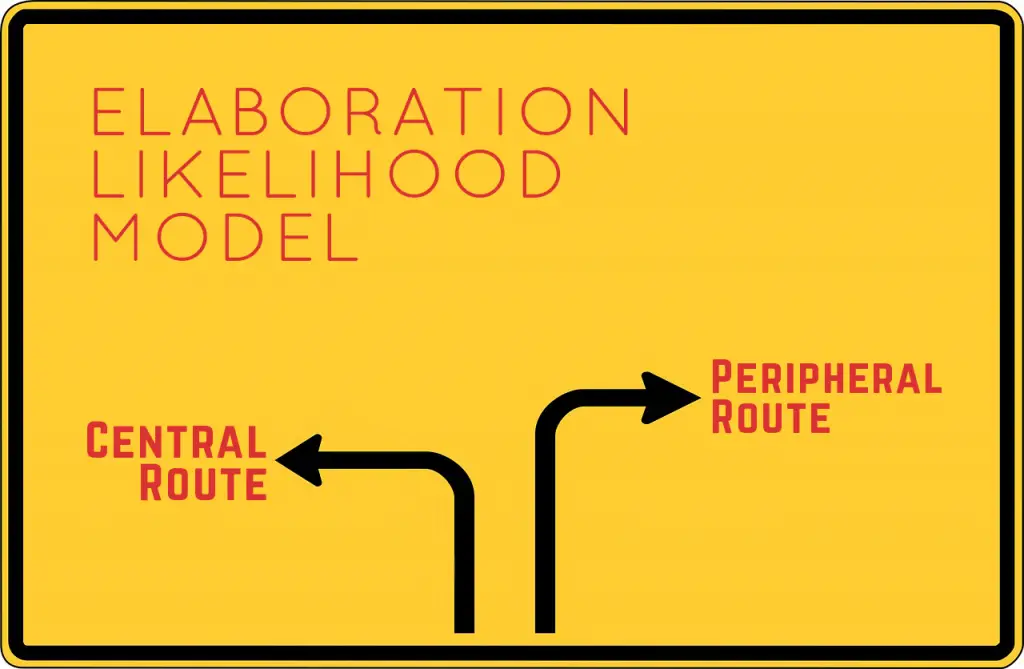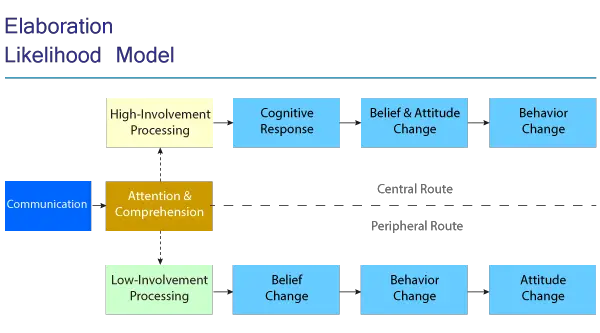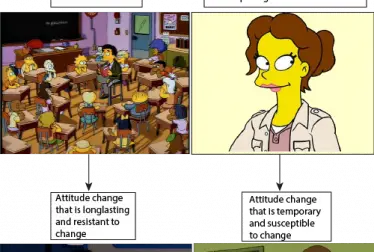Before we understand Central Route of Persuasion, we need to learn a bit about the Elaboration Likelihood Model of Persuasion.
Elaboration likelihood model of persuasion is an advertisement and marketing communication model which talks about persuasion level of messages given out in advertisements. The model was made by Richard E. Petty and John T. Cacioppo in 1980s.
Elaboration likelihood model has two routes that can be taken to persuade people. These are known as Two Routes of Persuasion. They are central route persuasion and peripheral route persuasion.

When an advertisement is shown, the message shown must be able to attract the person so that the person agrees to change his/her behavior. Different attitudes are formed and changed through it.
According to the model, there are four types of people:
- Gullible people who are easily influenced
- Skeptic, opinionated and argumentative people who cannot be easily influenced
- People with firm beliefs but with bad communication skills
- People who are leaders, who trust others as well as make others follow their thinking and ideas
These groups show how most people behave as all people fall into one category or another. This is the psychological basis of persuasion.
Two Routes of Persuasion

According to theorists, persuasion happens in two ways which are the two routes of persuasion.
Central route persuasion talks about the duration of the message being shown to a person, the number of times, and the persuasiveness of the message. The audience is active here and they believe what is shown or told. If a content being shown is directly related, relevant and near to the person, then the person is more likely to be persuaded to change his/her behavior. It has facts, arguments, credibility, and expertise which pull audience attention.
Peripheral route of persuasion is not being persuaded by facts but by fame and popularity. It is superficial and is mostly based on attractiveness. It is not elaborated and audiences are passive. People use mental shortcuts for this. Change through this route is temporary and goes away quickly.

What is Central Route Persuasion?
Central route to persuasion is a concept from elaboration likelihood model by Petty and Cacioppo. It is a process of getting influenced by facts and reasoning.
Elaboration is the process of giving the same message again and again to persuade a person. It can be more descriptive or the same message, but should be shown for a long time.
If any message is elaborated, then the message recipient or the audience gets persuaded more. The message remains in the person’s subconscious mind, which makes them act irrationally at times.
Central Processing in this route has two prerequisites. They are:
- Motivation
- Ability to think
Motivation to change attitude or behavior comes from seeing the same thing for a long duration as well as when the content of the message is strong.
If a person can not think, the person will not give importance to message. The person will only think if he/she cares about the topic or does not get to understand the good features being described in the advertisement.
Features of Message in Central Route Persuasion

There are four features of messages used in central route persuasion. They are:
- Persuasive communication
Message given is one-sided and shows benefits. - Motivation to process
When a message is directly related to the person involved, the person will be willing to change his/her attitudes and behavior according to the message. - Ability to process
People do not get influenced while he/she is distracted and not listening. There will be barriers in communication. - Nature of arguments
A strong, convincing creative message can change behavior and attitudes.
Examples of Central Route Persuasion
While watching television, a person who is interested in cars sees a car advertisement. Though the person has a car, the person gets influenced by the features shown of a new model of car. The advertisement has shown facts and figures that really show the car to be better than what the person has been using.
This is a case of a central route to persuasion. The person has the motivation and an ability to comprehend. So, the person takes action and changes his/her behavior.
If a person is shown to be a terrorist by reputed media news, then people who watch it believe in it and think so too.
For example, you need to choose the president of students union in your university. If you are influenced by central route, then you hear what both leaders who have stood for election say and then decide who you’ll vote. But if you are influenced by peripheral route, you might vote the one who is better looking or who is more famous or who is a friend of your friend.
Differences between Central Route Persuasion and Peripheral Route Persuasion
- People who get influenced by peripheral route of persuasion are passive and are unwilling to think much about the message unlike that of central route persuasion.
- The peripheral route makes the message as interesting and attractive as possible to attract attention and make people change their behavior. Whereas, people belonging to the other category believe in authenticity and facts.
- “Attitude changes that result mostly from processing issue-relevant arguments (central route) will show greater temporal persistence, greater prediction of behavior, and greater resistance to counter persuasion than attitude changes that result mostly from peripheral cues”- Petty & Cacioppo, 1986
- Commercial advertisements use peripheral route while informative programs use the central route to persuasion.
- Central route transformations last longer than that of the peripheral route.
- There is high-involvement processing in central route whereas low-involvement processing in the peripheral route of persuasion.
